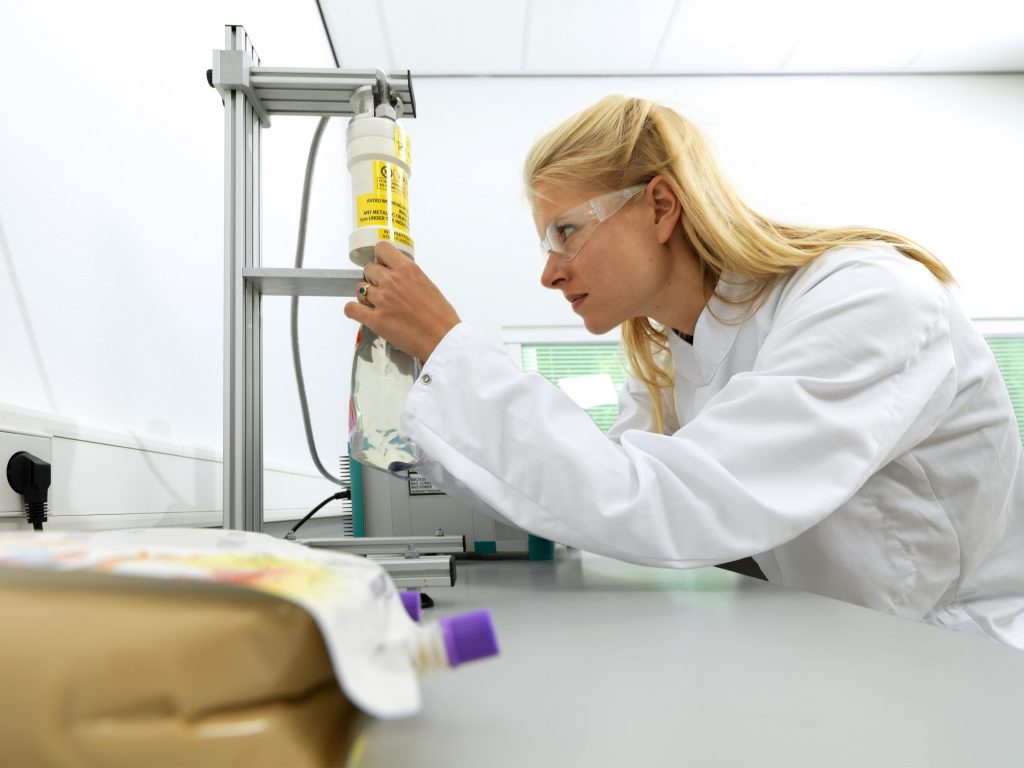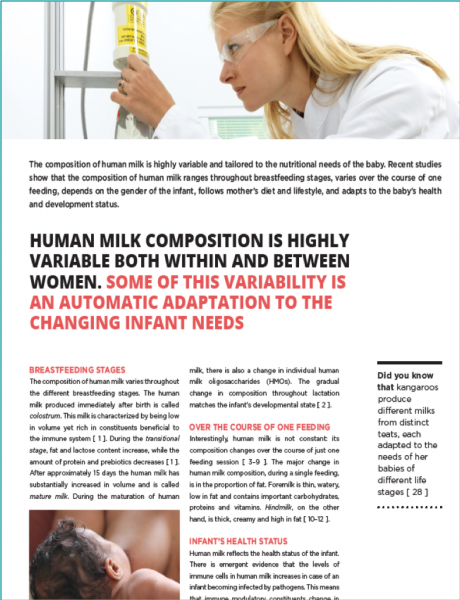Many factors can affect the composition of human milk, including diet, environment, genes, seasons and even a baby’s gender.
Breastfeeding stages
The composition of human milk varies throughout the different stages of breastfeeding. The milk produced immediately after birth is called colostrum. This is characterized by being low in volume yet rich in constituents that are beneficial to the immune system1. During the transitional stage, fat and lactose content increases, while the amount of protein and prebiotics decreases1.
After approximately 15 days, breast milk substantially increases in volume and is called mature milk. During the maturation of human milk, there is also a change in individual Human Milk Oligosaccharides (HMOs). The gradual change in composition throughout lactation matches the infant’s developmental state2.
Changes during feeding
Interestingly, human milk is not constant: its composition changes over the course of just one feeding session3–9. The major change in human milk composition during a single feed is in the proportion of fat. Foremilk is thin, watery, low in fat and contains important carbohydrates, proteins and vitamins. Hindmilk, on the other hand, is thick, creamy and high in fat10–12.
Infant’s health status
Human milk reflects the health status of the infant. There is emerging evidence that the levels of immune cells in human milk increases in cases where an infant has become infected by pathogens. This means that immune modulatory constituents change in response to active infection of the infant13,14.

Gender
Recent studies found that human milk from mothers of boys had 25% greater calorific content than from mothers of girls, as least in wealthy families. This is supporting faster growth in newborn boys15–18.
Season and climate
The composition of human milk can vary in different environments and different seasons. The water content can adapt to fulfill the liquid demands of an exclusively breastfed baby even in hot and dry environments19. Also, the amount of anti-pathogenic compounds in milk of women from different regions has been linked to infant pathogen risks associated with the specific environment20. Furthermore, distinct constituents of human milk, such as vitamin D or immune components, seem to vary depending on seasonal factors21,22.
Mother’s genes
The composition of human milk is influenced by the regulation of thousands of genes, making up approximately one quarter to one third of the total number of genes contained in the genome. A substantial part of worldwide variability in the quantity and quality of human milk components, like lipids and prebiotics, is linked to the genetic differences between mothers23–27.
Mother’s diet
Studies show that a mother’s diet, even during pregnancy, can influence the composition of human milk during breastfeeding. The maternal intake of several vitamins, minerals and a certain quantity and quality of fat are linked to the composition of human milk28,29. For example, some studies indicate a link between fish consumption and amounts of DHA* in human milk. Other studies show a positive correlation between dietary vitamin C and human milk concentrations of vitamin C.
Optimizing the maternal diet during pregnancy and lactation is important, not only to provide the baby with the best possible nutritional start for growth and immediate health, but to induce positive health effects that can last a baby‘s whole life29,30.
Culture and lifestyle
Maybe unknown to her, a great part of variability in human milk composition is influenced by a mother’s way of interacting with the environment and the culture of her social group. For example, family, friends or local culture often determine how a mother breastfeeds31-33. The readout of many genes involved in lactation is directly or indirectly influenced by cues from external and social environments. For example, the spacing and duration of feeds is as diverse as people’s general lifestyles. This culturally determined behaviour influences the constitution of human milk, such as fat, energy and water content31–33.
*DHA: Docosahexaenoic acid

Publication: Human milk composition is highly variable both within and between women
References
- Coppa, Giovanni V., et al. “Changes in carbohydrate composition in human milk over 4 months of lactation.” Pediatrics 91.3 (1993): 637-641.
- Hanson, Lars Å., et al. “The transfer of immunity from mother to child.” Annals of the New York Academy of Sciences 987.1 (2003): 199-206.
- Mizuno, Katsumi, et al. “Is increased fat content of hindmilk due to the size or the number of milk fat globules?.” International breastfeeding journal 4.1 (2009): 7.
- Hartmann. (2007) In: Hale & Hartmann’s Textbook of Human Lactation: 3-16
- Coppa, G. V., et al. “Prebiotics in human milk: a review.” Digestive and Liver Disease 38 (2006): S291-S294.
- Newburg, David S. “Are all human milks created equal? Variation in human milk oligosaccharides.” Journal of pediatric gastroenterology and nutrition 30.2 (2000): 131-133.
- Gluckman, Peter D., et al. “Effect of in utero and early-life conditions on adult health and disease.” New England Journal of Medicine 359.1 (2008): 61-73.
- Field, Catherine J. “The immunological components of human milk and their effect on immune development in infants.” The Journal of nutrition 135.1 (2005): 1-4.
- Blewett, Heather J. Hosea, et al. “The immunological components of human milk.” Advances in food and nutrition research. Vol. 54. Academic Press, 2008. 45-80.
- Lönnerdal, B. O. “Effects of maternal dietary intake on human milk composition.” The Journal of nutrition 116.4 (1986): 499-513.
- Neville, Margaret C., et al. “Studies on human lactation. I. Within-feed and between-breast variation in selected components of human milk.” The American journal of clinical nutrition 40.3 (1984): 635-646.
- Allen, Jonathan C., et al. “Studies in human lactation: milk composition and daily secretion rates of macronutrients in the first year of lactation.” The American journal of clinical nutrition 54.1 (1991): 69-80.
- Hassiotou, Foteini, et al. “Maternal and infant infections stimulate a rapid leukocyte response in breastmilk.” Clinical & translational immunology 2.4 (2013): e3.
- Riskin, Arieh, et al. “Changes in immunomodulatory constituents of human milk in response to active infection in the nursing infant.” Pediatric research 71.2 (2012): 220.
- Fujita, Masako, et al. “In poor families, mothers’ milk is richer for daughters than sons: A test of Trivers–Willard hypothesis in agropastoral settlements in Northern Kenya.” American journal of physical anthropology 149.1 (2012): 52-59.
- Hinde, Katie, et al. “Holsteins favor heifers, not bulls: biased milk production programmed during pregnancy as a function of fetal sex.” PloS one 9.2 (2014): e86169.
- Michaelsen, Kim Fleischer, et al. “The Copenhagen Cohort Study on Infant Nutrition and Growth: breast-milk intake, human milk macronutrient content, and influencing factors.” The American journal of clinical nutrition 59.3 (1994): 600-611.
- Powe, Camille E., Cheryl D. Knott, and Nancy Conklin‐Brittain. “Infant sex predicts breast milk energy content.” American Journal of Human Biology: The Official Journal of the Human Biology Association 22.1 (2010): 50-54.
- Sachdev, H. P. S., et al. “Water supplementation in exclusively breastfed infants during summer in the tropics.” The Lancet 337.8747 (1991): 929-933.
- Morrow, Ardythe L., et al. “Human milk oligosaccharides are associated with protection against diarrhea in breast-fed infants.” The Journal of pediatrics 145.3 (2004): 297-303.
- Ala-Houhala, M., et al. “25-Hydroxyvitamin D and vitamin D in human milk: effects of supplementation and season.” The American journal of clinical nutrition 48.4 (1988): 1057-1060.
- Salameh, Khalil, et al. “Prevalence and risk factors for low vitamin D status among breastfeeding mother–infant dyads in an environment with abundant sunshine.” International journal of women’s health 8 (2016): 529.
- Lemay, Danielle G., et al. “The bovine lactation genome: insights into the evolution of mammalian milk.” Genome biology 10.4 (2009): R43.
- Maningat, Patricia D., et al. “Gene expression in the human mammary epithelium during lactation: the milk fat globule transcriptome.” Physiological genomics 37.1 (2009): 12-22
- Ameur, Adam, et al. “Genetic adaptation of fatty-acid metabolism: a human-specific haplotype increasing the biosynthesis of long-chain omega-3 and omega-6 fatty acids.” The American Journal of Human Genetics 90.5 (2012): 809-820.
- Coppa, Giovanni V., et al. “Oligosaccharides in 4 different milk groups, Bifidobacteria, and Ruminococcus obeum.” Journal of pediatric gastroenterology and nutrition 53.1 (2011): 80-87.
- Thurl, Stephan, et al. “Variation of human milk oligosaccharides in relation to milk groups and lactational periods.” British Journal of Nutrition 104.9 (2010): 1261-1271.
- Lönnerdal, B. O. “Effects of maternal dietary intake on human milk composition.” The Journal of nutrition 116.4 (1986): 499-513.
- Wong, William W., et al. “Effect of dietary cholesterol on cholesterol synthesis in breast-fed and formula-fed infants.” Journal of lipid research 34.8 (1993): 1403-1411.
- Mennella, Julie A., and Gary K. Beauchamp. “Maternal diet alters the sensory qualities of human milk and the nursling’s behavior.” Pediatrics 88.4 (1991): 737-744.
- Anderson, Steven M., et al. “Key stages in mammary gland development. Secretory activation in the mammary gland: it’s not just about milk protein synthesis!.” Breast Cancer Research 9.1 (2007): 204.
- Lemay, Danielle G., et al. “Gene regulatory networks in lactation: identification of global principles using bioinformatics.” BMC systems biology 1.1 (2007): 56.
- Solter, Aletha Jauch. The aware baby. Shining Star Press, 2001.
BA19-485
